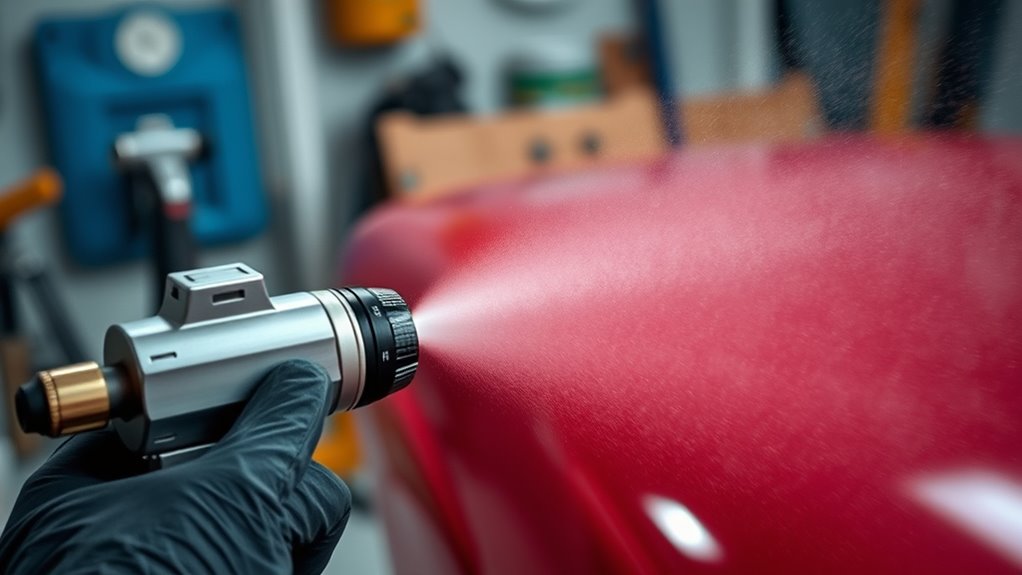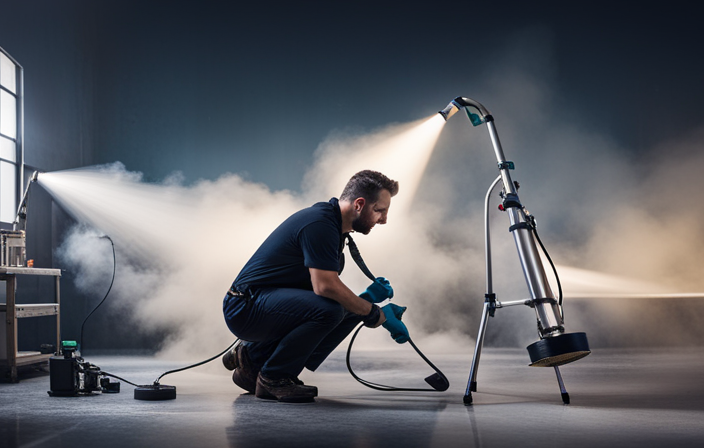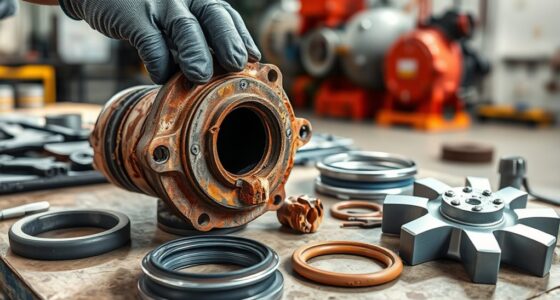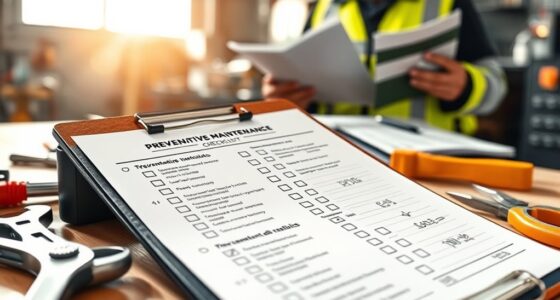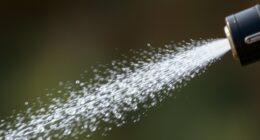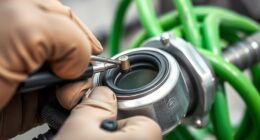To diagnose overspray problems, start by inspecting your spray gun for clogs, worn parts, or incorrect pressure settings, as equipment issues are common causes. Verify your environment is controlled; high humidity, dust, or wind can affect paint dispersion. Focus on your technique—hold the gun properly and maintain consistent movement. Proper maintenance and a stable workspace help reduce overspray. Keep exploring these tips for more effective ways to control overspray and achieve a cleaner finish.
Key Takeaways
- Inspect and maintain spray gun components regularly to prevent clogs and ensure consistent spray patterns.
- Control environmental factors like humidity, dust, and airflow to reduce airborne overspray.
- Adjust spray gun settings and technique, such as distance and stroke speed, for even paint application.
- Identify equipment issues, including worn parts or improper pressure, that cause uneven paint dispersal.
- Protect surrounding areas and surfaces from overspray by using covers and working in controlled conditions.
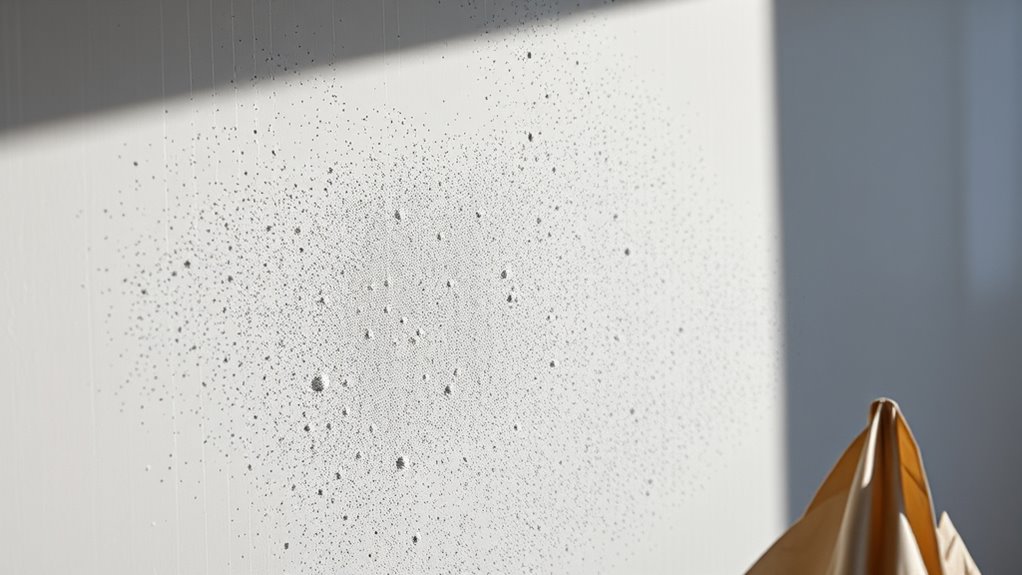
Overspray issues can quickly turn a painting project into a frustrating ordeal, but diagnosing the problem is the first step toward fixing it. When you notice excessive or uneven paint dispersal, it’s time to evaluate your spray gun setup and the surrounding environment. Proper spray gun maintenance is essential; if your equipment isn’t clean and well-maintained, it can cause inconsistent spray patterns, leading to overspray. Regularly cleaning your nozzle, fluid tip, and air cap prevents clogs and guarantees the gun functions at its best. Check for worn or damaged parts, as these can disrupt airflow and spray consistency. Maintaining your spray gun isn’t just about cleaning; it also involves inspecting seals and adjusting pressure settings to match your project requirements.
Environmental controls play a determining role in managing overspray. High humidity, dust, or temperature fluctuations can influence how paint atomizes and settles. For example, painting in a poorly controlled environment can cause the paint to dry unevenly or become airborne prematurely, resulting in overspray. To mitigate this, set up a controlled workspace — use dust barriers, proper ventilation, and climate control to stabilize temperature and humidity levels. This creates a more predictable environment for your spray gun to operate in, reducing the chances of overspray. Additionally, maintain consistent airflow to avoid turbulence, which can cause paint to drift beyond the target surface.
Adjusting your spraying technique is another key aspect. Holding the gun at the correct distance from the surface, typically 6 to 12 inches, helps control the spray pattern and minimizes excess paint. Keep your strokes smooth and even, overlapping each pass by about 50%, to prevent buildup and overspray. Don’t rush the process; patience and consistency are key. Also, consider the type of paint you’re using—thicker coatings require different spray parameters than thinner ones. Always refer to the manufacturer’s recommendations for best spray settings.
Furthermore, understanding the importance of proper equipment maintenance can significantly reduce overspray, ensuring your tools perform optimally and produce cleaner results. Finally, be mindful of your environment throughout the project. Avoid painting in windy conditions or outdoors when air currents are unpredictable, as this can carry overspray beyond your intended area. Cover nearby surfaces and objects to protect them from unintended paint. By combining diligent spray gun maintenance, environmental controls, and proper technique, you can noticeably reduce overspray issues. Over time, these practices will help you achieve cleaner, more professional results, making your painting efforts more efficient and less frustrating.
Frequently Asked Questions
Can Overspray Affect Indoor Air Quality Long-Term?
Yes, overspray can affect your indoor air quality long-term by releasing chemicals into the air. When you’re exposed to these airborne particles, you risk ongoing chemical exposure, which can cause respiratory issues and other health problems over time. To protect yourself, guarantee proper ventilation during painting projects and use low-VOC paints. Regular air quality checks can also help you monitor and reduce potential health risks.
How Does Humidity Influence Overspray Development?
Imagine a misty window fogging up—humidity impact on overspray development is similar. When humidity levels rise, paint particles linger longer in the air, increasing overspray spread. High humidity makes controlling overspray more difficult because the moisture causes paint to behave unpredictably. To improve overspray control, keep humidity low during painting, use dehumidifiers, and ensure proper ventilation, preventing excess moisture from worsening overspray issues.
Are Certain Paint Types More Prone to Overspray?
Yes, certain paint types are more prone to overspray, especially those with higher viscosity or fast drying times. When you choose paint with poor adhesion properties, you’re more likely to encounter overspray issues. Proper surface preparation is essential—you need a clean, smooth surface to minimize overspray. Using the right paint for your project and preparing the surface thoroughly helps reduce overspray and ensures a better finish.
What Safety Precautions Should Be Taken During Overspray Cleanup?
You should always wear protective gear like masks, goggles, and gloves during overspray cleanup—studies show PPE reduces exposure risks by over 80%. Keep spill containment supplies nearby to prevent overspray from spreading. Ventilate the area well and avoid inhaling fumes. Proper disposal of contaminated materials is essential. These precautions ensure your safety and help maintain a clean, hazard-free workspace during cleanup efforts.
Can Equipment Adjustments Prevent Future Overspray Issues?
Yes, adjusting your equipment can prevent future overspray issues. You should regularly calibrate your equipment to guarantee accurate spray patterns and consistent paint flow. Selecting the correct nozzle for your project also plays a vital role; a nozzle with the right size and type reduces overspray by delivering paint precisely where needed. These adjustments improve efficiency, reduce waste, and help maintain a cleaner work environment.
Conclusion
Tackling overspray issues is like solving a puzzle—you need to identify the cause and apply the right solution. By inspecting your equipment, adjusting your techniques, and maintaining proper conditions, you can markedly reduce overspray. Remember, catching these problems early is like catching a small leak before it floods your workspace. Stay attentive, keep fine-tuning your process, and you’ll achieve a smooth, flawless finish every time.
